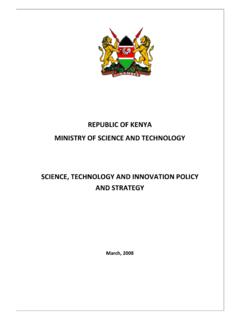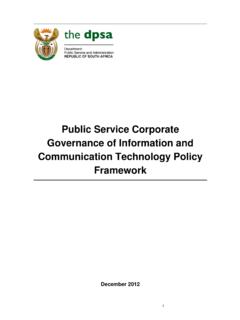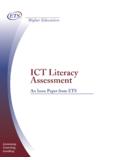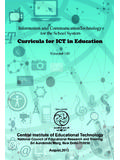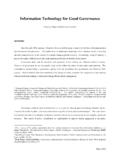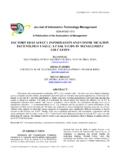Transcription of NATIONAL INFORMATION & COMMUNICATIONS …
1 REPUBLIC OF KENYA. NATIONAL INFORMATION &. COMMUNICATIONS technology (ICT). policy . BY. MINISTRY OF INFORMATION &. COMMUNICATIONS . JANUARY 2006. TABLE OF CONTENTS. VISION AND MISSION 1. 1. INTRODUCTION .. 2. 2. STATUS OF ICT IN KENYA .. 2. THE policy AND REGULATORY 3. 2. CHALLENGES OF ICT IN NATIONAL DEVELOPMENT .. 4. INTRODUCTION .. 4. policy , LEGAL AND REGULATORY FRAMEWORK .. 4. ICT 4. HUMAN RESOURCE DEVELOPMENT .. 5. ELECTRONIC LEARNING .. 5. UNIVERSAL ACCESS .. 6. PUBLIC-PRIVATE PARTNERSHIPS (PPP).. 6. ELECTRONIC 6. ELECTRONIC COMMERCE .. 7. CONTENT DEVELOPMENT .. 7. ELECTRONIC SECURITY .. 7. ICT 7. ENGENDERING 8. YOUTH AND ICT .. 8. 3. INFORMATION technology .. 9. INTRODUCTION .. 9. policy 9. STRATEGIES .. 10. 4. 16. INTRODUCTION .. 16. policy 16. STRATEGIES .. 17. LICENSING OF BROADCASTING SERVICES.
2 19. MARKET 20. SIGNAL 21. DIGITAL BROADCASTING .. 21. HUMAN RESOURCE DEVELOPMENT .. 22. ENVIRONMENTAL ISSUES .. 22. EQUITY PARTICIPATION & CONTROL .. 22. CROSS-MEDIA OWNERSHIP .. 22. SOCIAL 23. 5. TELECOMMUNICATIONS .. 24. INTRODUCTION .. 24. policy 24. STRATEGIES .. 25. TARGETS .. 26. TELECOMMUNICATIONS LIBERALISATION .. 26. i EQUITY 26. MARKET 27. BROADBAND 31. REGIONAL TELECOMMUNICATIONS INFRASTRUCTURE .. 32. FACILITY SHARING .. 33. RIGHTS OF WAY .. 33. MULTIMEDIA SERVICES .. 33. STANDARDISATION .. 33. DISASTER 33. TELECOMMUNICATION RESEARCH & 34. ENVIRONMENTAL ISSUES .. 34. 6. POSTAL 35. INTRODUCTION .. 35. policy 35. STRATEGIES .. 35. LIBERALISATION OF POSTAL SERVICES .. 36. MARKET 36. POSTAL 39. PHILATELIC SERVICE .. 39. INTERNATIONAL 40. 7. RADIO FREQUENCY SPECTRUM .. 41. INTRODUCTION .. 41. policy 41.
3 STRATEGIES .. 41. 8. UNIVERSAL 44. INTRODUCTION .. 44. policy 44. STRATEGIES .. 45. FINANCING UNIVERSAL ACCESS .. 45. ESTABLISHMENT OF ICT CENTRE OF EXCELLENCE .. 46. 9. INSTITUTIONAL FRAMEWORK FOR policy IMPLEMENTATION .. 47. INTRODUCTION .. 47. ROLE OF 47. ICT policy ADVISORY SECRETARIAT .. 47. ICT SECTOR REGULATOR .. 48. ICT APPELLATE TRIBUNAL .. 48. ROLE OF DEVELOPMENT PARTNERS .. 48. ROLE OF THE CIVIL SOCIETY .. 48. ROLE OF INVESTORS AND OPERATORS .. 48. ROLE OF CONSUMERS AND USERS .. 49. ANNEX I MARKET - 1 - ANNEX 2 - GLOSSARY OF - 4 - ii VISION AND MISSION STATEMENTS. VISION. A prosperous ICT-driven Kenyan society MISSION. To improve the livelihoods of Kenyans by ensuring the availability of accessible, efficient, reliable and affordable ICT services. 1. 1. INTRODUCTION. BACKGROUND. Countries that have harnessed the potential of INFORMATION and COMMUNICATIONS Technologies (ICTs) have attained significant social and economic development.
4 In addition, they are rapidly transforming into INFORMATION and knowledge-based economies. The Government, therefore, recognizes the role of ICTs in the social and economic development of the nation and has promulgated a NATIONAL ICT. policy based on the Economic Recovery Strategy for Wealth and Employment Creation (2003-2007). This policy seeks to facilitate sustained economic growth and poverty reduction; promote social justice and equity; mainstream gender in NATIONAL development; empower the youth and disadvantaged groups; stimulate investment and innovation in ICT; and achieve universal access. It is based on internationally accepted standards and best practices, particularly the COMESA Model adopted by the COMESA Council of Ministers in March 2003. The policy is based on four guiding principles: infrastructure development, human resource development, stakeholder participation and appropriate policy and regulatory framework.
5 STATUS OF ICT IN KENYA. Kenya has witnessed significant growth in the ICT sector as demonstrated by the number of telephone lines, Internet Service Providers (ISPs), the number of Internet users, broadcasting stations, and market share of each one of them. The Government has liberalised the mobile cellular market and currently, there are two mobile cellular operators. Available statistics indicates that there were: (a) 260,000 fixed telephone line subscribers and million cellular mobile subscribers by June 2004, translating into fixed teledensity of per hundred inhabitants for fixed and per hundred inhabitants for mobile against the world average of 19 and 21 respectively. 2. (b) 73 registered ISPs, 16 of which are active, approximately 1,030,000. users and over 1000 cyber cafes and telephone bureaus by June 2005.
6 (c) 16 operational television stations and 24 FM radio stations. (d) Approximately 11,500 public phones installed throughout the country by the year 2003. (e) An estimated 60% of the population have access to television and 90%. have access to radio services. THE policy AND REGULATORY FRAMEWORK. In 1997, the Government released the Telecommunications and Postal Sector policy Guidelines that created an environment for competition in several market segments and paved way to the enactment of the Kenya COMMUNICATIONS Act of 1998 which repealed the Kenya Posts and Telecommunications Act and established: (a) CCK as the Telecommunications, Radio COMMUNICATIONS and Postal Sector Regulator;. (b) NATIONAL COMMUNICATIONS Secretariat (NCS) to serve as a policy advisory body;. (c) COMMUNICATIONS Appeals Tribunal;. (d) Telkom Kenya Limited; and (e) Postal Corporation of Kenya.
7 3. 2. CHALLENGES OF ICT IN NATIONAL DEVELOPMENT. INTRODUCTION. The broad challenge is to harness the potential of ICTs for economic growth and poverty reduction. Specific challenges include lack of a comprehensive policy and regulatory framework, inadequate infrastructure, and insufficient skilled human resources. policy , LEGAL AND REGULATORY FRAMEWORK. Currently, ICT issues are considered under various legislation including: The Science and technology Act, Cap. 250 of 1977, The Kenya Broadcasting Corporation Act of 1988 and the Kenya COMMUNICATIONS Act of 1998, which are inadequate in dealing with issues of convergence, electronic commerce and e-Government. There is need for a comprehensive policy , legal and regulatory framework to: (a) Support ICT development, investment and application;. (b) Promote competition in the industry where appropriate.
8 (c) Ensure affordability and access to ICT nationally;. (d) Address issues of privacy, e-security, ICT legislation, cyber crimes, ethical and moral conduct, copyrights, intellectual property rights and piracy;. (e) Support research and development in ICT; and (f) Develop an institutional framework for policy development and review. ICT INFRASTRUCTURE. The lack of adequate ICT infrastructure has hampered provision of efficient and affordable ICT services in the country. Emphasis will be placed on: a) Provision of support infrastructure, such as, energy and roads;. b) Supporting software development;. 4. c) Promotion of local manufacture and assembly of ICT equipment and accessories; and d) Provision of incentives for the provision of ICT infrastructure. HUMAN RESOURCE DEVELOPMENT. The Government recognizes the role played by the various institutions providing ICT education and training.
9 However, there is need to strengthen and streamline the training through: a) Promoting ICT in education at primary, secondary, tertiary and community levels by developing ICT curricula and ensuring that teachers/trainers possess the requisite skills;. b) Setting up a framework for evaluating and certifying ICT training programmes;. c) Developing a mechanism for attracting and retaining skilled human resources;. d) Establishing networks for sharing training resources; and e) Developing strategies to support research and innovation. ELECTRONIC LEARNING. The lack of a policy framework on e-learning has hampered its development and utilisation. In this regard, there is need to: a) Provide affordable infrastructure to facilitate dissemination of knowledge and skill through e-learning platforms;. b) Promote the development of content to address the educational needs of primary, secondary and tertiary institutions.
10 C) Create awareness of the opportunities offered by ICT as an educational tool to the education sector;. d) Facilitate sharing of e-learning resources between institutions;. 5. e) Promote centres of excellence to host, develop, maintain and provide leadership of better learning resources and implementation strategy;. f) Exploit e-learning opportunities to offer Kenyan education programmes for export; and g) Integrate e-learning resources with other existing resources. UNIVERSAL ACCESS. Access to ICT services is limited to a few major towns leaving out the rural areas of the country where most Kenyans live. There is therefore need to enhance universal access through: a) Provision of adequate resources to the ICT sector;. b) Developing the requisite ICT infrastructure;. c) Creating incentives for service providers to deploy services in rural and under-served areas.
